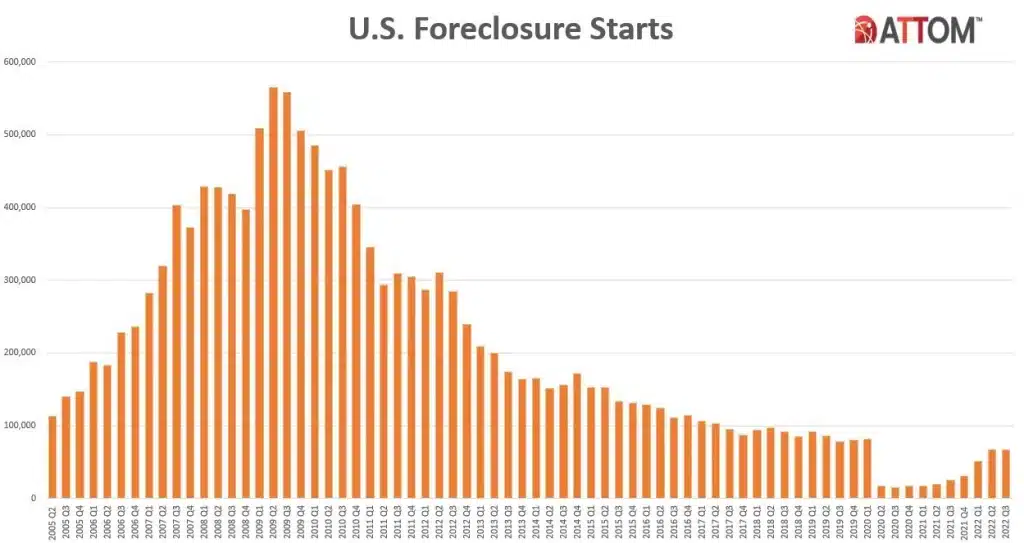We all remember the housing crash of 2008 even if we didn’t own a home. It is something that stays embedded in our minds. As we take a look at the market over the last year, some of us have been at the edge of our seats wondering where it’s headed. Some say we’re headed for another crash, while others say it will dip down a bit but not crash like it did in 2008. Over the last few years, homes on the housing market have been flying off the shelves. Interest rates have been amazing and everyone has been wanting to buy–so much so that builders can’t build homes fast enough. In this article, we have broken down some of the main indicators that suggest why the housing market won’t crash.
3 Reasons Experts are Saying the Housing Market Won’t Crash
- There isn’t an oversupply of homes for sale. There is currently a housing shortage. Builders are not able to build homes fast enough and inventory is still flying off the shelves, which is a great indicator that we are not headed toward a housing market crash.
- Lending Standards Are Tighter Today. In 2008, lenders would hand out a loan to just about anyone, not minding their credit or how much money was in their bank accounts. The lending standards are now tighter due to lessons learned and new regulations enacted after the last crisis.
- Record Levels of Equity Provide Security. Homeowners are continuing to benefit from rising home prices. Record levels of home equity provide financial security for millions.
Increasing Home Supply
The housing supply is increasing this last year. People are putting their homes up for sale to benefit from the increased equity they are getting out of their homes. Some homes have built up to over 100,000 in the last two years. Inventory is up by 27.8%, according to Calculated Risk. Inventory is still historically low and there aren’t enough homes on the market to cause prices to crash.
New Builds Are Coming on the Market
New builds are slowing down a bit as no one wants to see a repeat of 2008, but just because they’re slowing down doesn’t mean the market is crashing. It just means builders are playing things safe since interest rates have gone up and buyers have slowed down a bit. This is a sign that they’re being intentional about not overbuilding homes as they did during the housing bubble.
According to the latest data from the U.S Census, at today’s current pace, we’re headed to build a seasonally adjusted annual rate of about 1.4 million homes this year. While more inventory is being added to the market, it is not a pace to create an oversupply.
Lending Standards are Under Control
Lenders aren’t handing out money like they used to. They are thoroughly vetting their borrower before handing out money, making sure they’re getting all the correct documents before going forward with the deal.
Short Sales or Foreclosures Are Relatively Less of an Issue
Another place inventory can come from is distressed properties, including short sales and foreclosures. Back in 2008, there was a flood of foreclosures due to the lending standards. With more qualified borrowers there are fewer foreclosures in today’s market. Even though foreclosures have been increasing month over month, the number or foreclosures are still significantly lower than during the market crash of 2008.
Image Source: https://www.attomdata.com/news/market-trends/foreclosures/attom-september-and-q3-2022-u-s-foreclosure-market-report/
Key Housing Market Statistics to Consider
- A total of 30,881 U.S. homes had foreclosure filings — default notices, scheduled auctions, or bank repossessions — as of May 2022, according to ATTOM Data Solutions.
- Illinois had the highest foreclosure rate of any state in May, at one foreclosure filing for every 2,000 housing units, according to ATTOM. It’s followed by New Jersey, where one in every 2,346 homes is in some stage of foreclosure.
- Lenders repossessed 2,857 U.S. properties through completed foreclosures — known as “real estate owned,” or REO — in May 2022. Illinois had the most REOs at 350, followed by Michigan’s 249, according to ATTOM.
- Home sales fell 8.6 percent from May 2021 to May 2022, the National Association of Realtors says. The median house price reached $407,600 in May 2022.
- Homes’ rate of appreciation, per NAR, was 14.8 percent from May 2021 to May 2022.
Demographic Trends
Demographic trends are also creating new buyers. There’s a strong demand for homes on many fronts. More and more millennials are wanting to invest in buying a home, knowing how much they can make in equity, and more are buying. Hispanics are also a young and growing demographic that is buying more and more homes in the United States. People in their 30s are driving the housing market right now but people in their 70s and 80s could take the wheel in the next decade.
Final Thoughts
Many of us are worried that we are in for another downfall with the housing market due to the economy heading towards a downward spiral (or so it feels)–but that is not the case. The market is perpetually fluctuating, but while we have no crystal ball and can’t definitively predict the future, from this vantage point, it seems the most important indicators point to no housing market crash in the near future.
This article is intended for informational purposes only.
This article is meant for general informational purposes and is not intended to constitute financial advice to any person. The information within should not be used for financial investment decisions or any other financial purposes, and to seek independent financial advice from an appropriate professional. The author does not give any warranty as to the accuracy of any information in the paper to any person for purposes of financial decisions.
© Weekly Real Estate News. This article may be used in marketing efforts only if full and clear credit is given to Weekly Real Estate News and a link is provided to the original article.














While it’s nice to have hope and confidence in the real estate space, much of data seems to be portrayed out of context. For reference, 1 in 12 houses purchased in 2022 are underwater. That’s not good.
More than that, the writing of this specific article is not very good. For instance, it’s not “down roll spiral”, it’s “downward spiral”. In any case, those of us in the industry should be focused on our markets and how best to serve the folks in our communities and not solely on promoting positivity when it’s not all positive.